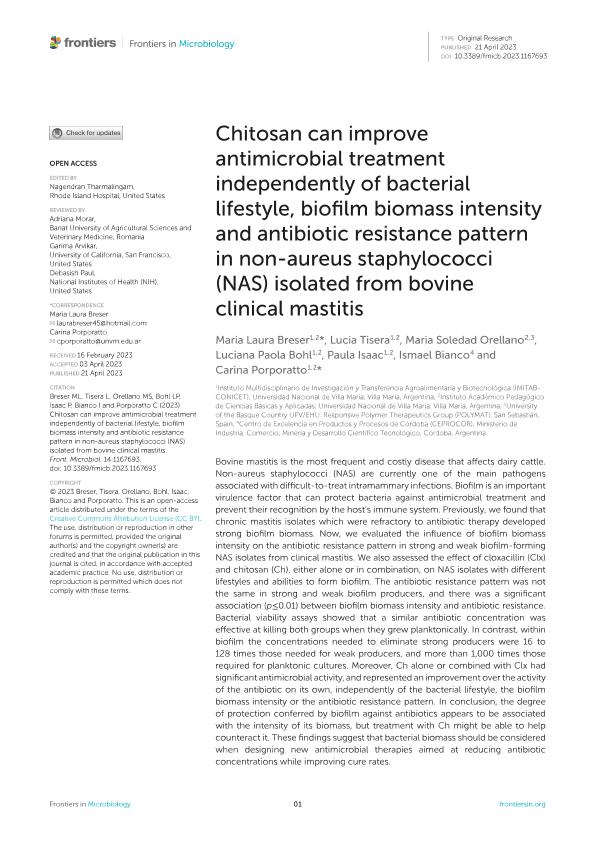Artículo
Chitosan can improve antimicrobial treatment independently of bacterial lifestyle, biofilm biomass intensity and antibiotic resistance pattern in non-aureus staphylococci (NAS) isolated from bovine clinical mastitis
Breser, Maria Laura ; Tisera, Lucía
; Tisera, Lucía ; Orellano, María Soledad
; Orellano, María Soledad ; Bohl, Luciana Paola
; Bohl, Luciana Paola ; Isaac, Paula
; Isaac, Paula ; Bianco, Ismael Dario
; Bianco, Ismael Dario ; Porporatto, Carina
; Porporatto, Carina
 ; Tisera, Lucía
; Tisera, Lucía ; Orellano, María Soledad
; Orellano, María Soledad ; Bohl, Luciana Paola
; Bohl, Luciana Paola ; Isaac, Paula
; Isaac, Paula ; Bianco, Ismael Dario
; Bianco, Ismael Dario ; Porporatto, Carina
; Porporatto, Carina
Fecha de publicación:
04/2023
Editorial:
Frontiers Media
Revista:
Frontiers in Microbiology
ISSN:
1664-302X
Idioma:
Inglés
Tipo de recurso:
Artículo publicado
Clasificación temática:
Resumen
Bovine mastitis is the most frequent and costly disease that affects dairy cattle. Non-aureus staphylococci (NAS) are currently one of the main pathogens associated with difficult-to-treat intramammary infections. Biofilm is an important virulence factor that can protect bacteria against antimicrobial treatment and prevent their recognition by the host’s immune system. Previously, we found that chronic mastitis isolates which were refractory to antibiotic therapy developed strong biofilm biomass. Now, we evaluated the influence of biofilm biomass intensity on the antibiotic resistance pattern in strong and weak biofilm-forming NAS isolates from clinical mastitis. We also assessed the effect of cloxacillin (Clx) and chitosan (Ch), either alone or in combination, on NAS isolates with different lifestyles and abilities to form biofilm. The antibiotic resistance pattern was not the same in strong and weak biofilm producers, and there was a significant association (p ≤ 0.01) between biofilm biomass intensity and antibiotic resistance. Bacterial viability assays showed that a similar antibiotic concentration was effective at killing both groups when they grew planktonically. In contrast, within biofilm the concentrations needed to eliminate strong producers were 16 to 128 times those needed for weak producers, and more than 1,000 times those required for planktonic cultures. Moreover, Ch alone or combined with Clx had significant antimicrobial activity, and represented an improvement over the activity of the antibiotic on its own, independently of the bacterial lifestyle, the biofilm biomass intensity or the antibiotic resistance pattern. In conclusion, the degree of protection conferred by biofilm against antibiotics appears to be associated with the intensity of its biomass, but treatment with Ch might be able to help counteract it. These findings suggest that bacterial biomass should be considered when designing new antimicrobial therapies aimed at reducing antibiotic concentrations while improving cure rates.
Archivos asociados
Licencia
Identificadores
Colecciones
Articulos (IMITAB)
Articulos de INSTITUTO MULTIDISCIPLINARIO DE INVESTIGACIÓN Y TRANSFERENCIA AGROALIMENTARIA Y BIOTECNOLÓGICA
Articulos de INSTITUTO MULTIDISCIPLINARIO DE INVESTIGACIÓN Y TRANSFERENCIA AGROALIMENTARIA Y BIOTECNOLÓGICA
Articulos(CCT - CORDOBA)
Articulos de CTRO.CIENTIFICO TECNOL.CONICET - CORDOBA
Articulos de CTRO.CIENTIFICO TECNOL.CONICET - CORDOBA
Citación
Breser, Maria Laura; Tisera, Lucía; Orellano, María Soledad; Bohl, Luciana Paola; Isaac, Paula; et al.; Chitosan can improve antimicrobial treatment independently of bacterial lifestyle, biofilm biomass intensity and antibiotic resistance pattern in non-aureus staphylococci (NAS) isolated from bovine clinical mastitis; Frontiers Media; Frontiers in Microbiology; 14; 4-2023; 1-12
Compartir
Altmétricas



